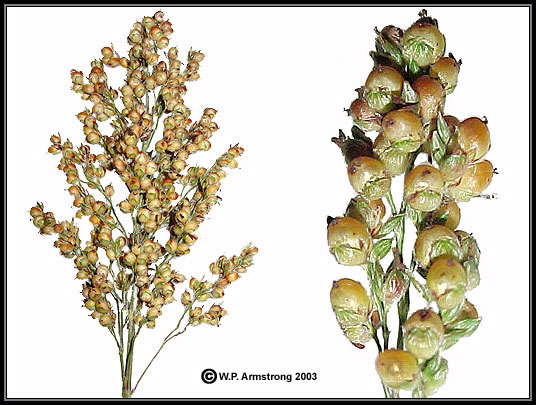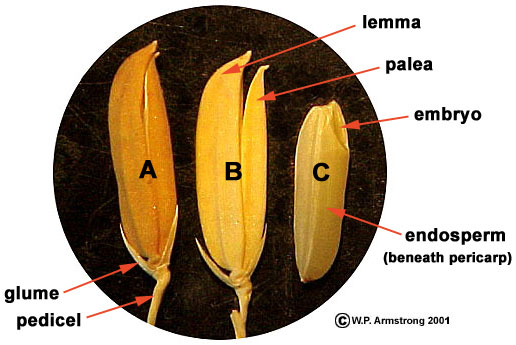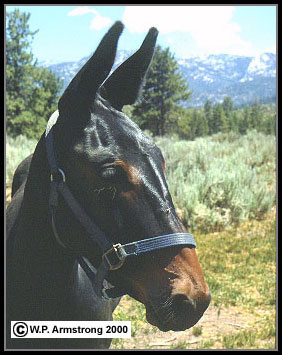Photos Of Some Important Cereal Grasses
Rye, Wheat, Sorghum & Rice
Grass Family (Gramineae or Poaceae)
The grass family (Poaceae) is a large family of 10,000 species and at least 600 genera. Grasses range in size from small annuals (Poa annua) to towering, timber bamboo (Dendrocalamus giganteus). This is unquestionably the most important plant family, providing the majority of food for humans and their domesticated animals. The grasses are relatively recent additions to the earth's flora, having evolved only 30 to 40 million years ago, long after the demise of the dinosaurs. Vast grasslands provided food for the rising age of herbivorous mammals which in turn provided the food for a variety of carnivores. In addition to cereal grains (rice, wheat, barley, oats and corn), grasses are the source of bamboo shoots used in Asian foods, the primary source of sugar (sucrose) from sugar cane (Saccharum officinarum), alcoholic beverages from barley malt (beer) and fermented rice (sake), and bamboo timbers for construction and scaffolding.
|
Grasses For Biofuel Production
Brazil produces ethanol from sugar cane which provides fuel for automobiles. Ethanol burns cleaner than petroleum-based fossil fuels and it eliminates a country's dependence on mid-east oil reserves. A native grass of the North American prairie may have a greater biomass potential than sugar cane. It is called switchgrass (Panicum virgatum) and it is one of the dominant species of the central North American tallgrass prairie. It is a perennial grass that sprouts in late spring and grows rapidly to a height of 6.5 feet (2 m) or more during the hot summer months. As a C-4 plant, switchgrass is photosynthetically efficient during the very hot summer in dry, parched soils. Some estimates state that switchgrass has the potential to produce 1,000 gallons of ethonol per acre, compared with 665 gallons for sugar cane and 400 gallons for corn. There is considerable disagreement on these estimates, and some researchers state that the potential for ethanol production from cellulose may be much lower. In fact, University of California professor Tad Patzek claims that switchgrass requires 45 percent more fossil energy than the ethanol produced. The Helios Project at Laurence Berkeley Laboratory is actively trying to produce bacterial strains than will more efficiently convert cellulose into ethanol.
|

|
Important cereals: A. Oats (Avena sativa); B. Barley (Hordeum vulgare); C. Bread Wheat (Triticum aestivum); D. Rye (Secale cereale).
|

|
A. Bread wheat (Triticum aestivum); B. Rye (Secale cereale); C. Triticale (Triticosecale). Wheat and rye are crossed together to produce the hybrid triticale.
|
Rye (Secale cereale)
Rye (Secale cereale) is a diploid plant (2n) composed of 2 sets of chromosomes (DD), each set with 7 chromosomes (D=7). [Note: The word "set" is defined here as one haploid set of chromosomes.] Therefore, the diploid number, or number of chromosomes in the rye sporophyte (DD), is 14. Bread wheat is a hexaploid (6n) composed of 6 sets of chromosomes (AA, BB & CC), each set with 7 chromosomes (A=7, B=7, C=7). Therefore, the number of chromosomes in the wheat hexaploid sporophyte (AABBCC) is 42. Triticale (Triticosecale) is a bigeneric hybrid between wheat (Triticum aestivum n=21) and rye (Secale cereale n=7). The resulting hybrid (ABCD) contains one set of rye chromosomes (D) and 3 sets of wheat chromosomes (ABC), a total of 28 chromosomes (7 + 21). It is sterile because the rye (D) set has no homologous set to pair up with during synapsis. This sterile hybrid seedling is treated with colchicine to produce a plant with twice as many chromosomes (i.e. 2A's, 2B's, 2C's and 2 D's), a total of 56. The fertile hybrid is an octoploid (8n) because it contains 8 sets of chromosomes. The diploid rye plant (DD) can also be crossed with tetraploid durum wheat (T. turgidum AABB) to produce a sterile triploid hybrid with 3 sets of chromosomes (ABD). This hybrid is treated with colchicine to produce a fertile hexaploid (6n) version of triticale (AABBDD).
Wheat (Triticum turgidun & T. aestivum)
Durum wheat (Triticum turgidum ) is derived from wild emmer wheat of Syria. Emmer wheat is a tetraploid hybrid (4n=28) between einkorn wheat (T. monococcum or a relative) and a grass similar to the present-day goat grass (T. speltoides = Aegilops speltoides); or possibly T. longissima or T searsii. The original diploid (2n=14) emmer wheat was probably sterile because it contained only 2 sets of chromosomes, one from the einkorn parent (n=7) and one from the goat grass parent (n=7). Through a natural doubling of the chromosomes, a fertile tetraploid emmer wheat with 4 sets of chromosomes was produced. A mutation in the tetraploid emmer wheat, causing the bracts (glumes) enclosing the grain to break away readily, gave rise to the tetraploid durum wheat (T. turgidum or T. turgidum var. durum). The readily detachable grain makes the separation of the grain from the chaff relatively easy and is why durum wheat is called a "free-thrashing" type of wheat.
Tetraploid wheat also contains two proteins that combine to form a tenacious complex called gluten. Because of gluten, the wheat flour becomes elastic when mixed with water and kneaded, and when yeast is added, it rises into firm loaves. Yeast cells in the dough undergo fermentation and release carbon dioxide which becomes trapped in the glutinous protein mass. Baking "sets" the dough by drying the starch and denaturing the gluten protein. As the dough bakes, the carbon dioxide gas expands into larger bubbles, thus producing the porous, spongy texture of bread. Corn does not make good loaves of bread because it lacks gliadin, one of the key proteins of gluten. Consequently, corn bread crumbles and falls apart easily.

|
Two slices of bread made from different grains: Corn bread (left) and whole wheat (right). Corn bread does not make a firm loaf because it lacks gliadin, one of the key proteins of gluten. Without the elasticity of gluten, corn bread crumbles and falls apart readily.
|
Bread wheat (T. aestivum) is also a free-thrashing type of wheat. It is a hexaploid (6n) hybrid, four sets from an emmer wheat parent and two additional sets from a wild, weedy species (T. tauschii = Aegilops squarrosa). The endosperm of this hybrid wheat is especially high in protein and surpasses other wheats for bread making.
Soft wheat varieties generally have a lower protein and gluten content. They are used in biscuit, cake and pastry flours. Durum wheat has very hard, high protein kernels. It has been used for centuries to make pasta. Semolina is coursely ground grain, usually wheat, with particles between 0.25 and 0.75 mm in diameter. The Moroccan food "couscous" is made from semolina. Coursely ground corn (maize) is called "grits." Semolina used for pasta is made from durum wheat or another hard wheat. Semolina used for porridge or farina comes from non-durum "soft" wheat. It is known in the United States by the registered trademark name ® "Cream of Wheat."
Sorghum (Sorhgum bicolor)

|
Sorghum (Sorghum bicolor), an important cereal grass native to Africa that ranks fourth after rice, corn, and wheat in terms of importance for human nutrition. There are four main types of sorhgum based primarily on how it is used: (1) grain sorghums (including milo), (2) sweet sorghum or sorgo (used as animal food), Sudan grass (a different but related species), and broom-corn. Some grain sorghums are referred to as millet, but this term also refers to several other species of edible grasses, including Panicum milliaceum, Eleusine coracana, Eragrostis tef, and Pennisetum glaucum. Some of these drought resistant millets provide a vital food source for people in arid regions of Africa.
|

|
A healthy sorghum plant (Sorghum bicolor) growing in fertile soil.
|

|
Inflorescence of sorghum (Sorghum bicolor), showing numerous plump grains enveloped by green bracts (glumes).
|
Rice (Oryza sativa)
Rice (Oryza sativa) is one of the most important crop plants, and feeds more people than any other single plant species on earth. According to Simson and Ogarzaly (Economic Botany: Plants in Our World, 1995), it has been estimated that 1.7 billion people depend on rice. Cultivated in submerged rice paddies in Asia for thousands of years, this grain is also grown in many other parts of the world, including the Sacramento Delta flood plain in California's Central Valley. Like other cereal grains, there are different varieties of Oryza sativa, and different ways to mill and prepare the grains. Several different grass species in different genera are also called rice. Wild rice (Zizania aquatica) is native to North America and was harvested for food by native Americans. Another North American wild rice or Indian rice is Oryzopsis hymenoides, native to mountains and valleys of Canada and the western United States.
In polished white rice, the bran and germ has been milled off, creating a cereal that is more flavorful to many people. [The seed coat and pericarp of the grain is referred to as bran, and the germinating embryo is called the germ.] In polished white rice you are eating mostly the carbohydrate-rich endosperm tissue which lacks the vitamin B1 of the bran and germ. Since brown rice contains bran and germ, it is rich in vitamin B1. The disease known as beriberi is characterized by inflammation of the peripheral nervous system and a loss of muscle tone in the arms and legs. It is caused by a dietary deficiency of vitamin B1 that is aggravated by an imbalance of carbohydrate foods which lack this vitamin. The disease reached epidemic proportions in Asia and Africa among people who subsisted on a diet of white rice.
Puffed rice, made popular by Quaker Cereals at the 1904 World's Fair is actually shot from barrel devices in modern cereal factories. With the sudden release in pressure the superheated grains actually expand (puff). This method of grain enhancement is also applied to wheat.
|
Left: Herbarium specimen of a rice plant (Oryza sativa), the crop plant that feeds more people than any other single species on earth. Right: Close-up view of the inflorescence showing a number of brownish spikelets. Each spikelet consists of a pair of basal glumes and a pair of brown bracts (lemma and palea) that enclose each grain. The red arrow points to the lemma of an individual spikelet.
|

|
Rice (Oryza sativa). A. Grain-bearing spikelet showing a pair of slender basal bracts (glumes) and the stalk (pedicel). The inflorescence is composed of numerous spikelets, each bearing a rice grain. B. An empty spikelet with the lemma and palea slightly separated from each other. These two leathery bracts enclosed the grain or caryopsis. C. A grain (caryopsis) removed from spikelet (B). The embryo or germ is at upper end. Beneath the brownish outer pericarp and seed coat layers (called the bran) is the endosperm tissue. Most of the vitamin B1 is found in the germ and bran portions, which are milled off in polished white rice.
|

|
Grains of brown and polished white rice. In polished white rice (left), most of the bran and germ has been milled away, resulting in an improved flavor (at least to some people). The grains appear slightly more slender, with the apical germ region ground off giving the grains a slightly pointed appearance (red arrow). In white rice you are eating mostly the carbohydrate-rich endosperm tissue which lacks the vitamin B1 of the bran and germ. Even though it is less nutritious, white rice is still preferred by Asians, and is the most popular grain served in Chinese and Japanese restaurants in the United States.
|

|
Longitudinal section of a rice grain showing the embryo (germ), pericarp (bran ) and endosperm. In polished white rice, the nutritious germ and outer bran layers are removed. The seed coat is completely fused with the pericarp and is not visible in this image as a distinct layer.
|
|

